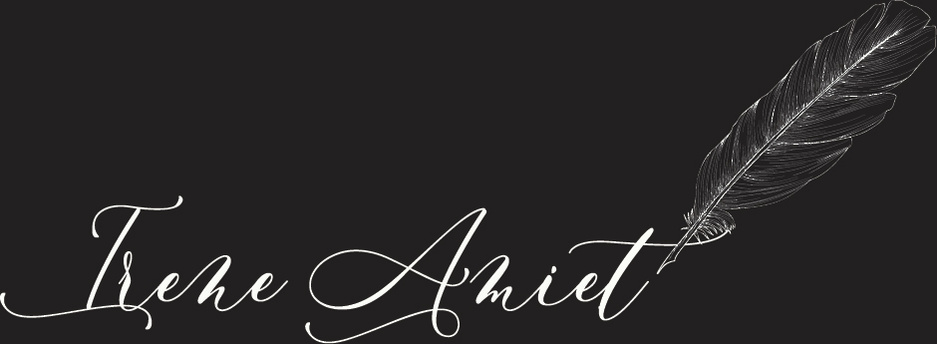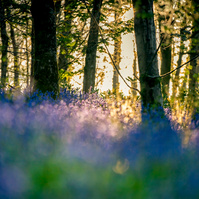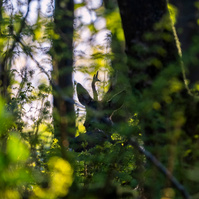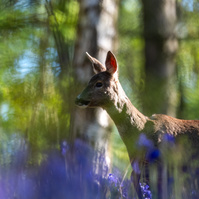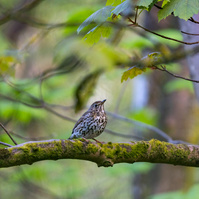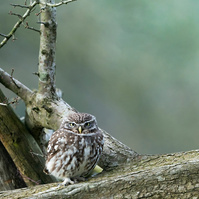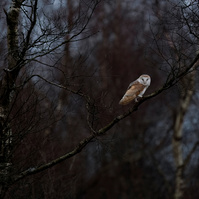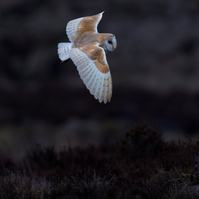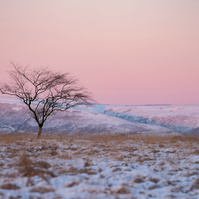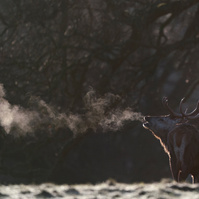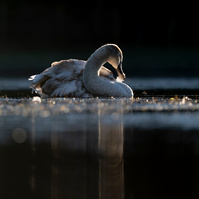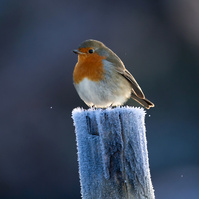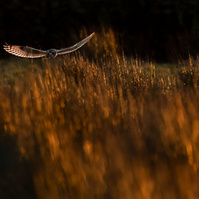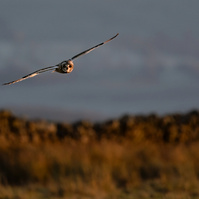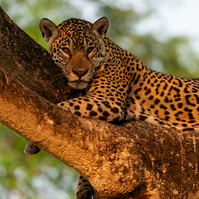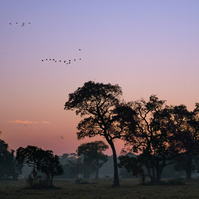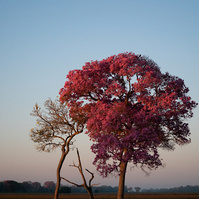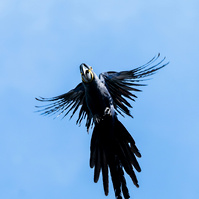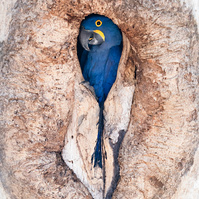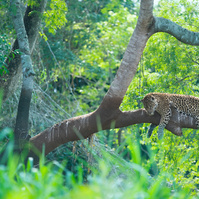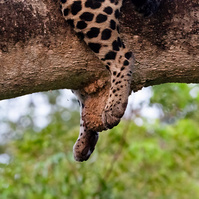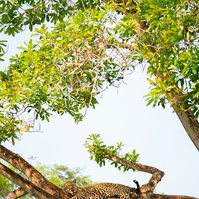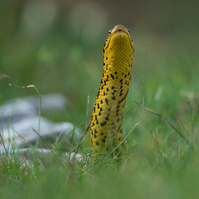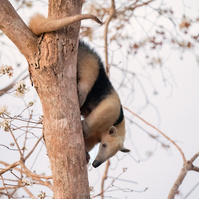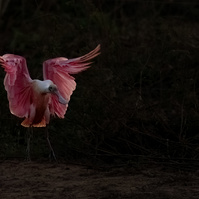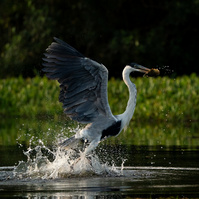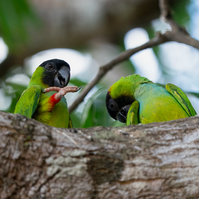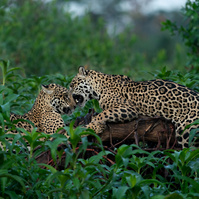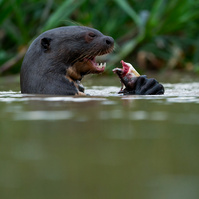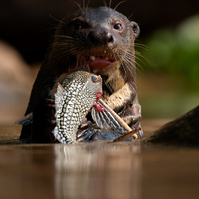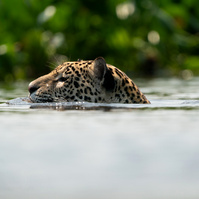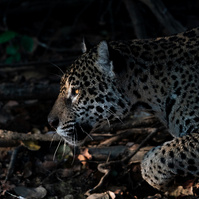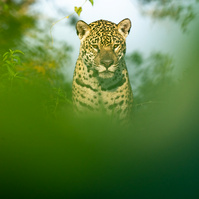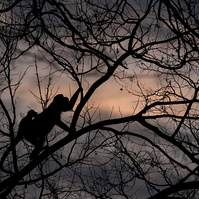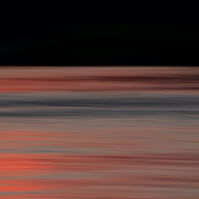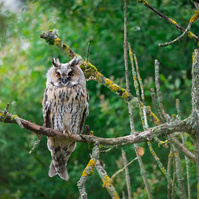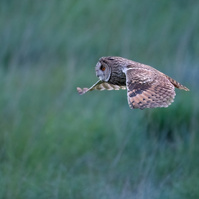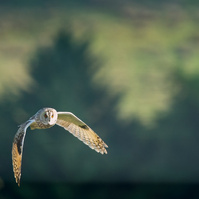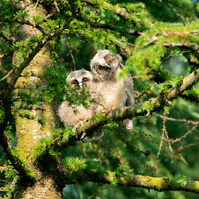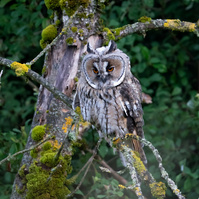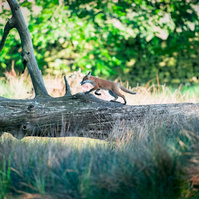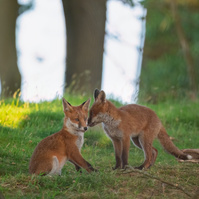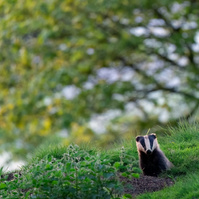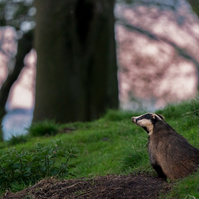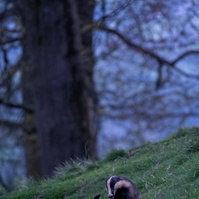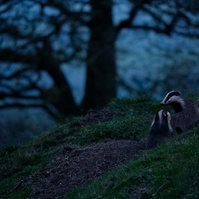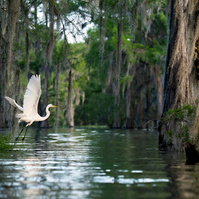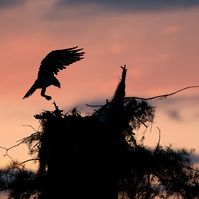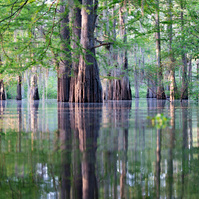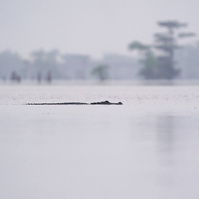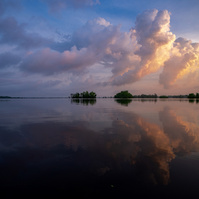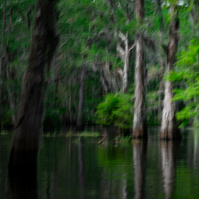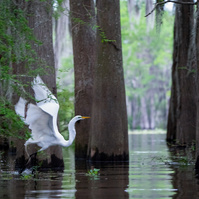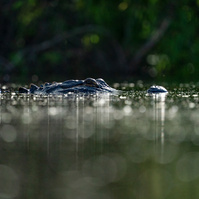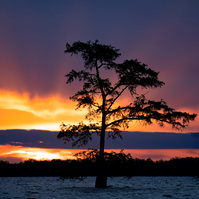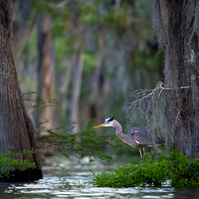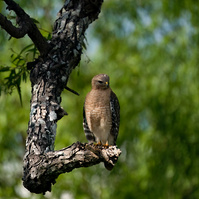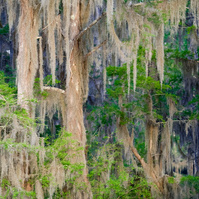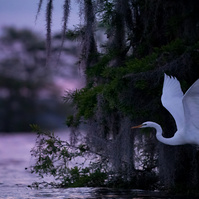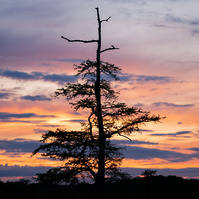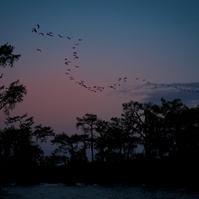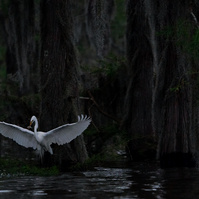Painted, crafted and formed by the ever turning dials of our universe, our woods are celebrating youth. Darkness dissolves, and like a slow lapping of silver waves, light moves through , reaching and unfurling just like the young ferns, rolling through silken strands of bluebells to tease the dye from strand and strand of forest fabric.
A woodpecker’s staccato is the only contrasting sound to the soft whisper in the leaves before the smaller birds fluff their feathers and start their soprano chorus of violins and flutes. Humankind’s machinations, charring voices, roads and traffic, hushed in the distance, fading for now.
In this clearing of age-old sycamore, ash and oak, life is full. A silhouetted antler behind a tree, a cracking of twigs. Stepping out of shyness’ shadow and into the light, dressed in russet, finely spun we watch each other quietly before she calmly passes on. A thrush then follows her passage, hoping and flying from branch to branch.
One morning a sound rolls through Bowland skies as if an orchestra of flute-playing sprites are sailing over our hills. Curlews have returned. Soon they’re joined by the rolling caw of lapwings and from every nook and cranny hares emerge, lured outside their forms by the ever-increasing strength of the sun that infuses the grass with a most enticing shade of golden green.
Daylight hovers at dusk, as if unwilling to disperse now that our flora starts marbling with the softest pastel hues which come to life under sun’s masterful creations.
Birds are turning our hedgerows into one great nest, proclaiming their projects’ progress to neighbours of every shape and form, meeting over a meal of worms that are shyly poking their heads from soft, churned soil. In the woods, the owl is hunting for their partner sitting on eggs in an old abandoned barn, hoping their home will hold for yet another season so new life has a chance to emerge.
Spring is not for the faint-hearted, but celebrates our potential’s full embrace. With every added breath of daylight, possibilities sprout for all who’re brave enough to dare, by choice or pulled by destiny’s strings, riding the hands on nature’s clock for yet another season, yet another turn of life.
Setting out in darkness with shards of glassy snow crunching below my boots, shed from the starry heavens, daylight soon seeps in sweet rose across a world that’s been iced by a million confectioners.
Robins fly about as tiny rusted feather-balls with dark marble eyes. One sits on the frosted dry-stone wall and starts to chirp, teaching me their song to brighten the morning.
The stags’ breath journeys in long streams above the cracking soil with antlers gleaming silver under a bright, cold sun. The herd huddles together, seeking warmth.
A lone buck joins them from across the dell, his hooves nimble like a dancer’s on an icy rink. We share the open meadow trying to capture some light on our hides as the few crisp dead leaves glow as cuts of shiny metal from steel branches, beautiful but cold.
This is mid-winter. The world is at its coldest, the source of all life withdrawn while all empty shells of old are whipped away under time’s unforgiving broom. And so we wait and gather thought and strength, appreciating each hour’s sunshine and the company we keep. On the lake, the cygnet preens her young costume over a sea of diamonds, in a festive jubilation of innocence and youth, all so fresh and new in her first year when a still cold morning holds nothing but promises in moments yet to unfold.
Those winter mornings when the land wakes glazed and the landscape is frozen, light reigns supreme. In pastel pinks and wintry blues it starts to paint hills dusted with powder white shards of ice and fields spiked with stiff, hard meadow-grass. On a dry-stone wall, against a warming sky, a silhouetted secret agents goes about his business of hunting. In the woods, shed leaves now crack under our steps and our eyes water in the stinging cold. Birds are hungry and flock together to find food, shedding their shyness in favour of finding seeds where they wouldn’t usually approach. Robins fluff their feathers on top of poles decorated by the season and perched on a silver birch branch sits the tawny owl, framed by frosted twigs in a diamond contraption while the melting ice starts thawing with bell-like sound under the waxing sun.
November carries heavy rain across the Northern Atlantic, which drench our moors for days on end. It’s a time to withdraw, shelter and to catch up with the year. It’s a time to be patient, because every so often, a sun breaks through and if it does, the light of an evening slides in at such an angle that the moors light up in copper and the hills are draped in royal blue. It’s the time for short-eared owls to arrive from the snow-covered North and hunt over our fells. Their piercing calls carry over hill-side and fields as they scour the ground for voles, their silver wings framed by the light. As the sun sets and the winds pick up, the owl perches every so often and only her eyes still catch the last of the autumn’s sun before the skies lose their saturation and day blends into night.
With amber eyes catching the mid-day sun, the jaguar lounges on a branch, paws hanging low over waterlilies where jacanas prance and donacobius birds balance on reed stems of stark jade green.
A merciless sun burns my neck and flies tickle where the sleeve of a long-cotton blouse ends to expose skin. The arm stays still, however, as the jaguar gets up on her haunches, her rosetted hide stretched over impressive shoulder-blades, and she jumps into the river. This time, the caiman escaped. Shaking off water much like a dog, she immediately resumes cat-like character by haughtily strutting past the six boats carrying people from all over the world who have come to the Parque Nacional do Pantanal Matogrossense to watch the world’s largest jaguar in their habitat.
Once a most elusive big cat, celebrated in lore and feared by the vaqueros, the cowboys of Brazil, jaguars have come to meet human kind (or vice versa) in the very centre of South America, the Pantanal. Here, in the world’s largest tropical flood-plane, a region of roughly 150,000 square km, jaguars reign supreme. The wetlands go through an annual circle of inundation and desiccation from rains of the high plains that drain into the Paraguay River system. Now it’s August and we’re in the dry season when roots along riverbanks are exposed like so many gnarled fingers reaching for water.
We had started the day at dawn as birds flew in from every direction; hyacinthe macaws, roseate spoonbill, caracaras and egret traveling over purple skies under the rolling, spooky sounds of howler monkeys that cloak the forest with their drumming vocals. First light hit the piuva trees in bloom, turning their pink blossoms into a fantasy land creation where cotton-candy grows on branches, ever sweeter with the intensifying hues of the waking morning.
The Pantanal teems with wildlife and a lucky visitor can find smaller cats like the ocelot and jaguarundi, reptiles like the striking yellow anaconda or the crafty giant river otters that hunt along the rivers loudly snacking on armoured catfish, as well as tapirs, giant anteaters and tamanduas. Pantanal bird-life is unparalleled, if not in number, then in density. River or grassland, any moment it’s perfectly feasible to spot half a hundred of the 740 different bird species. From the mighty jabiru stork of a wing-span of 2.8 metres in males, to the tiniest hummingbird, colourful feathers fleck and buzz the habitat like lightning-fast stitching across a tapestry of greenest silk.
Past noon we had found our jaguar: Dozing on a favourite perch along the Cuiabá River, she moved her head from one side to the other every ten minutes or so until an hour had passed and she started to hunt.
Jaguar comes from an indigenous word of the Guarani tribe meaning “she who kills in one leap.” And her demonstration of immediate action out of a soporific state proved her name true.
Because of their habit of killing prey by the neck, the jaguar’s jaw muscles are the strongest of any of the big cat’s and are responsible for their own thick neck where these muscles come together. Their back has a peak above the rib-cage, unlike their cousin, the leopard, whose back describes a downward curve. A further distinguishing mark is the small black dots in the middle of the rosettes of their fur pattern and a black tip of the tail. Jaguars like water and they are active any time of day as a quick swim will cool them in 45 degrees heat.
There’s no doubt the jaguar is a creature of beauty and for big cat enthusiast’s like myself, top of the wish-list of species to see. The thrill of a first encounter is unparalleled, but having always only seen prints of jaguars throughout Central America and along the Amazon, I had to come to the Pantanal to spot the spotty cats.
The national park was established in 1984 to protect a habitat equalled in diversity only by the Amazon, but much more accessible, especially once the Transpantaneira highway was built – a 147 km rutted runway stretching across 120 bridges from Ponconé in the North to Porto Jofre in the South. The road helped establish a tourism industry which brings employment to an extent where some of the cattle ranches situated in the Pantanal region now make over 50% of their profit from paying guests. In the past, a cow taken by a jaguar would have started a hunt, ending with at least one of the cats deemed responsible killed. Nowadays, a jaguar alive brings in much more revenue than would be saved from the potential safeguarding of cows.
In this sense, the confluence of rivers, inside the National Park, where the Cuiabá, the São Lourenço and Piquiri meet, is also a confluence of minds. Still endangered, the jaguar’s chances of extinction from hunting have lessened over the last decades as their worth has risen in a country where poverty is high and secure employment is valued. Our local expert guide, Sergio Freitas, who holds a doctorate in the taxology of river fish, hopes to convince the government that to avoid challenges from the ever-increasing number of visitors, a management plan for the park is essential. At the moment, boat drivers and guides work well together and jaguar sightings are shared to guarantee a great experience for all. Guests are quiet and something akin to a hush enwraps the boats that assemble in no time should a cat show close enough for photographers to fire their cameras from every angle. Once the jaguar disappears, the boats scatter and it’s possible to go for hours up and down the rivers without seeing another soul.
It’s obvious that the cats do not care about the many pairs of eyes watching their every move. This latest generation of jaguars has grown up under scrutiny and their behaviour is not affected. Sergio hopes this peaceful state will be sustained by officially regulating the industry with capacity numbers and impact studies. He also hopes to incorporate more conservation lectures into national school curricula with an eye to the future.
As we glide towards our house boat under a grenadine red sunset and trees turning charcoal black, the heat disperses too, and a welcoming breeze travels over the rivers, taking the day’s stories along with the egrets returning to roost and the howler monkeys climbing high into the crowns reaching for safety in the last light.
Of an early morning, amber eyes flit over dew-soaked meadows, wings buzzing quietly over thistle and grass, lifting, lowering, catching the breeze. Late of an evening, golden light catches on honeycomb wings. Often a shadow, now here, then gone, the long-eared owl is the elusive woodland royalty of Britain. Catching voles beyond a dry-stone wall as the sun filters through their feathers, they glide over moorland and field to the distant calling of their young. As the owls are hunting, the voles scampering and the deer peeking from behind shrubbery, the sun sets to provide the golden glow fanned by the bird’s wings. The slow passing of the light’s strength, the intensifying of colours before fading into pastels are part of the evening’s, the owl’s and my story. And when the chicks grow, they figure out the ways of an owl, to fly, to hide, to perch to match their forest home. In late summer, when the woods are changing – lichen turns ochre and gold, cobwebs trap dewdrops in the morning -the owl blends in with bark, amber eyes like gemstones in the forest’s crown. The young are now part of their habitat’s fabric to spin their tales along.
When there is nothing but bad news, doomsday approaching on poison-fume horses ridden by scythe swinging riders, I walk the woods. Patchy as they are nowadays, there are still places where the magic of old withdrew. It’s preserved in last year’s shed acorns crackling under your boots. It glimmers in the manifold green shades of beech, sycamore and oak the wind shifts like silk fans and it’s always in the light that gains strength by degrees as the sun wanders westward, more exuberant as the hours roll on, a gradient becoming smaller but more intense until it highlights naught but the center of one’s vision. At times, when waiting for the evening light, I fall asleep on bracken and breathe in dry earth and rotting reeds. Insects hover then move along and the birdsong becomes multifold, reaching me through slumber. When I open my eyes I find myself in a world of characters that dance and play through centuries. Furtive, then playful, wary then carefree, forever young. Those are the hours I share their world and restore my mind. It’s then that I refuse to believe the end to our planet is neigh. Given the right circumstances, a new willingness to share, the magic withdrawn into these small pockets of forest and dell will roll across hills and valleys again and make them wild once more.
With their keen sense of smell, badgers are a tricky species to photograph and patience is the only fitting key. After locating a suitable habitat, wooded dell with a beck flowing through, it’s the freshly dug-up earth in front of large, bean-shaped holes with dry grass outside that shows a potentially active badger sett. Finding a space down-wind where I can sit for at least an hour before sunset, I drape myself in camouflage gear, snuggled in warm, water-resistant clothing because the wait is long and my limbs need to remain as still as possible. It’s a time to clean your mind of thoughts disrupting the flow of imagination, until you sync with the hour and place until breathing is calm and the urge to move little.
Tall old oak and beech trees sway gently in the breeze above me with their bright leaves of fresh green and sheep bleat from across the Bowland Hills. Sunlight streams through the canopy, first golden, soon pastel and lilac. A brush-stroke of burnt orange rests on an oak’s textured bark, aglow for a while then thinning.
Somewhere a tractor travels back to a farm, then stillness. Pigeons squawk, ruffling the quiet and a hoot tells me of the presence of an owl. Again, it’s quiet. Waves of violet marble a sky dropping hue after hue.
The sun is setting and the last light hovers on the edge of the dell. There it is. The earth has come alive. Squeals and rabbles, chattering and harrumphs down below. The window of opportunity is open.
A nose appears from the sett entrance, followed by another and I aim my camera quietly, gently and steadily while my heart beats fast and my lips are set in a smile. A frame, two, three, then the badgers are off on their foraging.
The light fades into midnight blue.
The cubs come out as the moon rises and for a few minutes, the animals play like creatures drawn by an illustrator hopeful that moments of wonder like these may just exist. They do.
In darkness, I withdraw from the sett and the dell, trying not to break twigs or stumble as I circle back out and away from their nightly world.
In Southern Louisiana, where the people cook with spices hotter than the mid-day sun and speak in a French tongue as bumpy as the rutted country lanes, over 5 and a half thousand square kilometres the Atchafalaya Basin creates the largest swamp area of continental North America. Hard to access in its deepest pockets, the swamp is home to a great array of birds, from the ruby red cardinal dotting the shrubbery like pinpoints on felt to the long-legged, stalking white heron that find their morning catch on water sprinkled by dawn’s first light and the majestic bald eagle.
Like groves planted by an ancient culture, the cypress trees stand row on row, the columns of an edifice whose ceiling is made of branches intertwined, light filtering through to gild the emerald brocade hangings sweeping the jade-coloured marble floor below. Gliding through on a small boat, engine off, there is a calm emanating from the black water whose bottom one can’t see but out of which the scales of an alligator emerge at times, a few air bubbles betraying their presence and a glinting golden eye, soon to disappear again like the splashing catfish and the turtle jumping off a rotting branch.
Deeper into the thicket, moss builds a waving curtain swept aside to open a new chamber and then another yet again, creating a rambling temple that keeps building itself as plants grow until in the very centre, a young tree stands on its own, surrounded by its peers as if it were somehow special.
A kingfisher darts past like a jester with no reverence to the voodoo priestess that may reign here.
Where the river turns lake, the thicket becomes less dense and from one blink to the next, the landscape changes. This is where osprey call in alarm to ward off from their chicks, the red-shouldered hawk sits still, considering the geese young chicks as the sun lessens and ibis crisscross high above, their soft white wings rising over the watery wilderness as the setting sun paints the tree-line with abundance.
